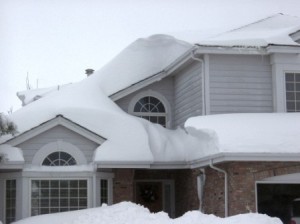Winter Roof Maintenance Tips
We know this is not the news Kansas City metro residents want to hear, but all signs point to a snowier winter this year. According to the Kansas City Star, areas of Kansas like Wichita received 30 inches of snow last year, tying previous records as the 5th snowiest winter on record. Typically, we see a good 14.7 inches of winter precipitation. However, this year, January is forecast to have above normal precipitation, with cooler arctic air and ridges in the upper atmosphere pushing cold surges across the nation’s mid-section. So what this means for homeowners is that it’s more important than ever to check out the roofing system before the snow flies and make sure you are buttoned down for the winter months!
Clean the gutters.
Autumn leaves left in gutters is one of the most common problems we see in the winter time when homeowners call to complain about leaky roofs. The melting snow sits on top of the heavy wet leaves and starts to back up onto the shingles, rather than go down the gutters and away from the home as designed. You may also want to consider installing gutter covers to prevent future debris accumulation.
Trim Surrounding Vegetation.
Are tree limbs hanging over your roof? A seemingly stable branch can give way under the pressure of frozen ice and snow during the stormier months. Take a good look at your tree situation and determine if your home is at risk. If you can’t reach the branches yourself, a contractor should be able to trim any wayward branches for $200 to $500.
Get The Roof Inspected For Leaks.
Stains on walls, missing shingles and indoor moisture accumulation are all signs of a roof that’s about to spring a major leak. There may be shingles that need a quick re-caulking, re-securing with metal flashing, or reinforcing with plastic cement. These small jobs shouldn’t cost you more than a few $100 at most and will give you peace of mind throughout the winter until the spring when you may want to pay for more substantial repairs or put up a new roof.
Check Your Attic.
Are all attic vents clear from obstructions? You may need to install more attic insulation or additional vents to prevent ice-damming if your home is prone to icicle formation. You should have one square foot of intake and exhaust ventilation for every 300 sq ft of attic space.

